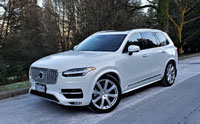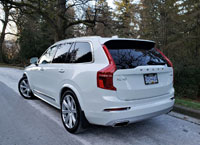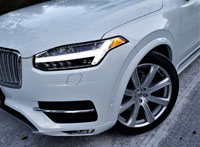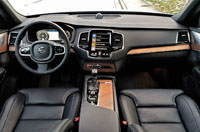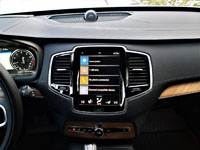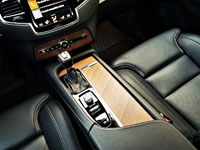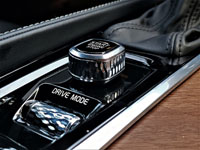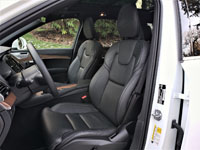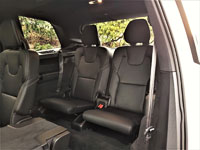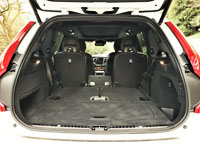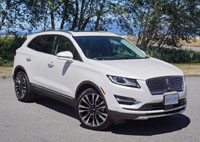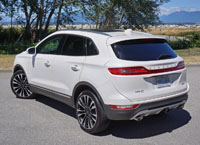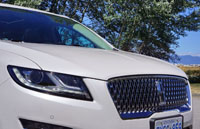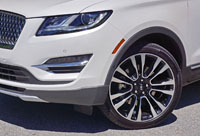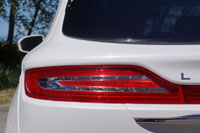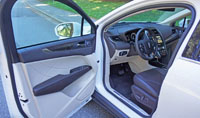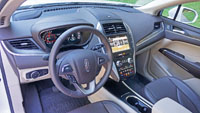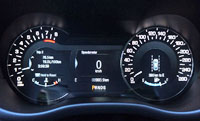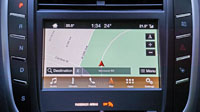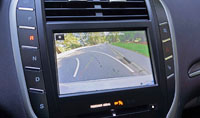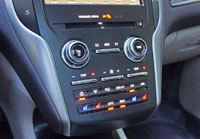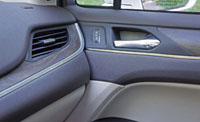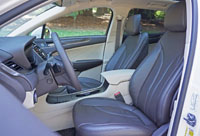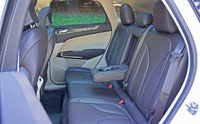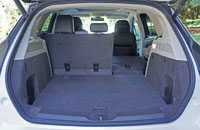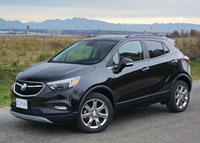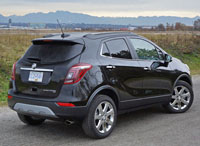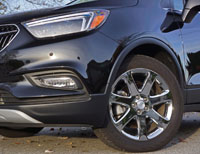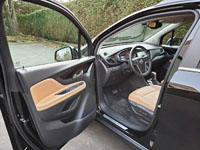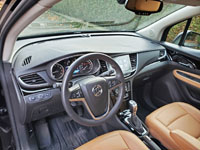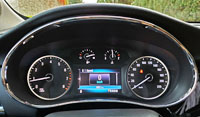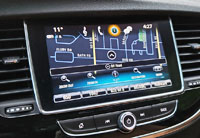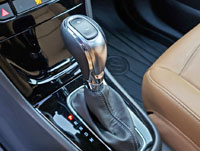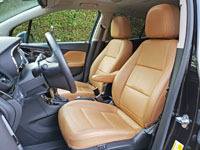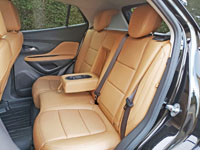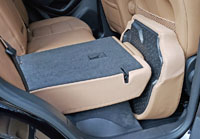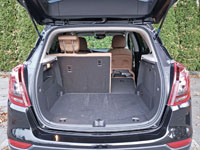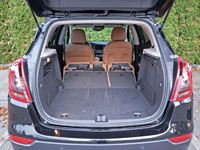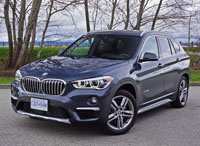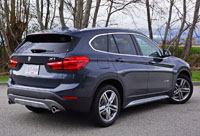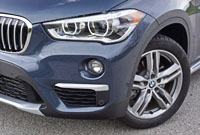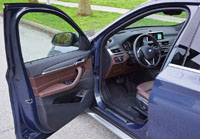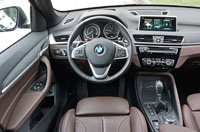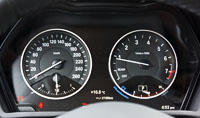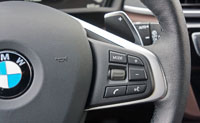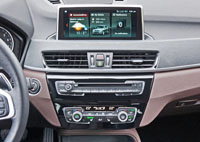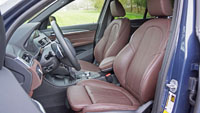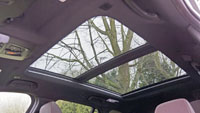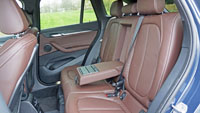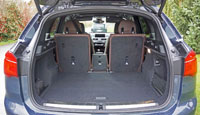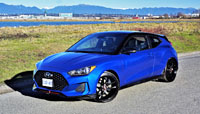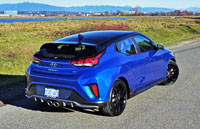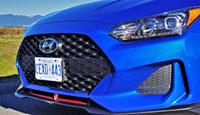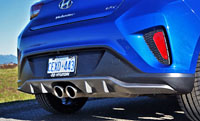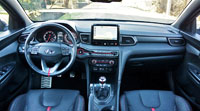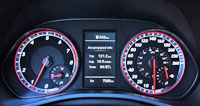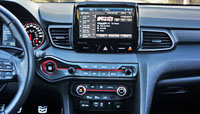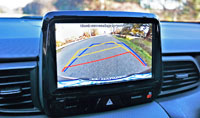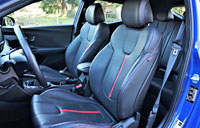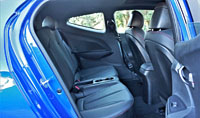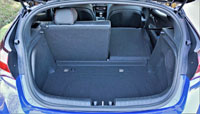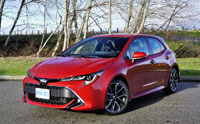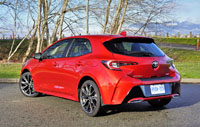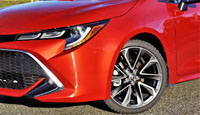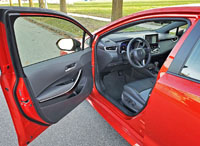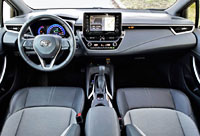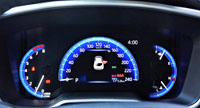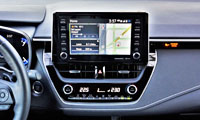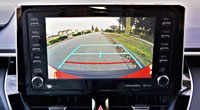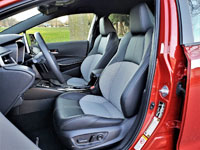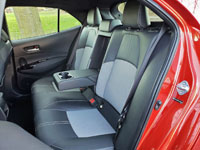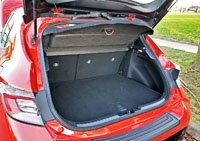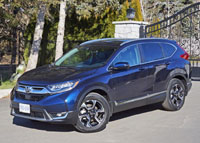
Honda’s CR-V is one of the top-selling sport utilities in Canada, and should do even better next year now that a sportier looking 2020 model is starting to arrive. The mid-cycle update revises its grille and front fascia, the latter including larger lower intakes plus new multiple-lens LED fog lamps in upper trims, which might not be a big deal to those not loyal to the popular model, but will no doubt cause fans to ante up if financing rates stay low.
There’s a good reason for the diehard loyalty. Truly, few compact crossovers are as wholly good as the CR-V, especially the 2019 Touring example provided to me for a recent weeklong test. I couldn’t begin to count the number of people I’ve recommended the CR-V to. Its build quality is better than average, refinement right at the top, comfort-oriented performance excellent, and practicality top-notch.
I’d say comfort and overall roominess are the CR-V’s strongest attributes. To this end the driver’s seat and steering column offers better adjustability than most in this class, fitting my longer-legged, shorter-torso body almost perfectly, which is not always the case in this class. Its tilt and telescoping steering column extends farther rearward than most others, while my tester’s 12-way power-adjustable driver’s seat provided ample movement for optimal comfort and control. Even better, its four-way powered lumbar support fit the small of my back perfectly, and should do the same for most any body type, with some premium models not even offering such an impressive level of driver’s seat control.
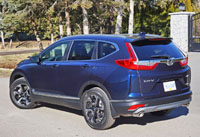
That 12-way powered driver’s seat is standard with EX, EX-L and Touring trims, incidentally, these being the upper half of a 2019 CR-V lineup that also includes LX-2WD and LX trims at the lower end. The lack of “2WD” in the other trims’ names isn’t a typo, by the way, but rather designates standard AWD in the rest of the lineup. Pricing for the base model starts at $27,690 plus freight and fees, while the same trim with AWD can be had for $30,490, the EX for $33,990, the EX-L for $36,290, and my Touring tester for $39,090.
Notably, the refreshed 2020 CR-V mentioned earlier starts $1,000 higher in base trim thanks to standard Honda Sensing, which means the base FWD model not only includes forward collision warning like it did last year, but also gets autonomous collision mitigation braking, lane departure warning with lane keeping assist and road departure mitigation, auto high beams, plus adaptive cruise control with low-speed follow.
The 2020 CR-V will also replace this year’s EX with new Sport trim that’s also priced $1,000 higher, while Honda increases the EX-L’s retail price by $1,500 plus adds $2,000 to this Touring trim next year. Last but not least, Honda pushes the new CR-V slightly upmarket with a $42,590 Black Edition that darkens much of the exterior trim and adds a set of black-painted alloy wheels. This model only comes painted in Crystal Black Pearl or $300 optional Platinum White Pearl, both of which look quite attractive.
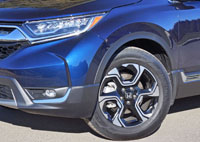
Being that Honda should have no problem selling all the 2019 CR-Vs currently in stock (and yes, there were still some available at the time of writing), the company isn’t dumping piles of cash on the hood to get rid of them (that would be the Pilot that you can get up to $4,000 in additional incentives right now, whether buying a 2019 or even a 2020). As it is, the additional incentives go up to $1,000 with both the 2019 and 2020 CR-V right now, as per the 2019 Honda CR-V Canada Prices page and 2020 Honda CR-V Canada Prices page right here at CarCostCanada, where you can also learn details about trim, package and individual option pricing, manufacturer rebate info, and dealer invoice pricing that will likely save you even more. CarCostCanada members are currently saving an average of $1,869 on 2019 and 2020 CR-Vs, so keep this in mind before heading off to your local CR-V dealer.
I can’t yet speak for the new 2020 CR-V, but my 2019 Touring model continues to be one of the most refined compact SUVs available from a mainstream volume producer. Its front door uppers and dash top were covered in nice premium-level pliable composites, but the former surfaces go a step further thanks to a particularly upscale feeling stitched leather-like material. The same is found on the instrument panel’s facing, made even nicer with a strip of gloss-black inlay running horizontally down the middle. At least as attractive, my Touring model’s faux hardwood trim features a stylish matte finish that looks quite realistic and feels denser than most others in the class that attempt hardwood, except Mazda’s CX-5 Signature that uses real Abachi wood veneers.
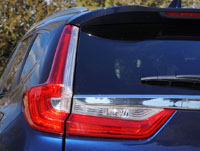
If I had to point to a competitive product that did a better job of mimicking premium than the CR-V Touring, it would be that CX-5 Signature. The genuine hardwood suits up with fabric-clad A-pillars as well as pliable composite door uppers in back, whereas its rear seats flip down in the optimal 40/20/40 split-folding setup. Like the CR-V, those rear seatbacks lower automatically via cargo sidewall levers, but I like Mazda’s efficient two-in-one release levers best. The CR-V is also hampered by its less than ideal 60/40-split rear seatbacks that aren’t anywhere near as accommodating for active lifestyle folks needing to carry longer items like skis down the middle. This allows rear passengers to benefit from the comfier outboard seats next to the window, and when seat warmers are added in back it make for less grumbling from the kids when both can enjoy a toasty hot seat after a cold day on the slopes.
The CR-V does include a handy adjustable cargo floor that moves up and down about three inches to either allow for taller stuff when lowered, or a rear floor section that meets up with the rear seatbacks when laid flat. When doing so the CR-V’s cargo volume expands from 1,110 litres behind the rear seatbacks to 2,146 litres, compared to just 875 and 1,687 litres respectively for the CX-5. By the way, this segment’s best-selling Toyota RAV4 is fairly large for the class too, but doesn’t quite measure up to the CR-V.
As far as space goes elsewhere in the CR-V, front and rear passengers have a lot to go around. I’ve covered the driver’s setup already, so suffice to say the front passenger, which gets four-way power adjustment in upper trims and four-way manual in lower trims (the LX driver’s seat is six-way manual), should be amply comfortable and have more than enough room to move around in.
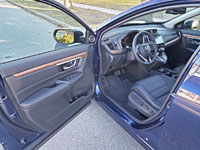
As for rear passengers, I sat directly behind the driver’s seat when it was set up for my body type (my hips are about as high as the average six-footer despite being five-foot-eight, so seat placement is approximately the same), which resulted in approximately 10 inches of space ahead of my knees, plus enough room to almost totally stretch out my legs with both feet under the front seat. Additionally, I had ample headroom and good movement from side-to-side, even when flipping the wide centre armrest down, while I also found the outboard positions provided comfortable lower lumbar support. The switches for my tester’s heated rear outboard seats were smartly positioned on the door panels ahead of the armrests, right behind those for the power windows.
What’s more, a couple of charged USB-A ports are fitted to the rear panel of the front console, while dual cupholders are included within the aforementioned centre armrest, and bottle holders can be found in the lower rear door panels. If Honda had added soft, pliable rear door uppers along with 40/20/40-split rear seatbacks, or at least a centre pass-through, it would rival the CX-5 for best-in-class luxury and refinement.
Back in the driver’s seat, the CR-V Touring model’s steering wheel includes a comfortably shaped, leather-clad rim that can be warmed by pressing a button on the left spoke, while the switchgear on both spokes is better than average in quality and functionality.
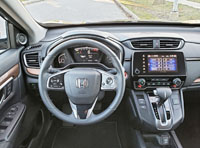
The CR-V’s digital gauge package remains very good for this class, although appearing like a large multi-information display surrounded by analogue temperature and fuel readouts means that it’s not as impressive as the Volkswagen Tiguan’s optional fully digital instrument cluster. Still it functions well and is easy to read, but won’t let you double navigation mapping and route guidance info directly in front of the driver, or most other infotainment features.
The 7.0-inch high-resolution touchscreen on top of the centre stack looks a lot larger than it actually is when the CR-V is turned off, this because of how seamlessly Honda integrated it within its gloss-black surrounding surface. Other than a power/volume knob on the bottom left corner, the interface is purely touch-sensitive, and like a personal tablet or smartphone can be controlled via tap, swipe and pinch finger gestures.
As noted in passing earlier, this top-line model included a navigation system, which had very accurate route guidance. The maps are attractive and well laid out, as are the system’s other graphics, which nice, bright colours and deep contrast, while it was easy to use, responded quickly to input, and even included a decent audio system, complete with satellite radio, USB inputs, Bluetooth streaming, and more. Smartphones can be connected via Android Auto or Apple CarPlay integration, and the rearview camera utilized active guidelines, these strangely not included with the CX-5 I lauded earlier in this review.
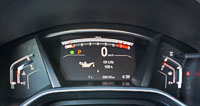
Getting an overhead sunglasses holder is nothing new, yet still much appreciated (as long as I remember to remove my sunglasses before returning a press car… I’ve lost at least half a dozen great pairs of sunglasses that way), but Honda goes a step further by including a built-in rear passenger conversation mirror, something not normally seen outside of minivan and mid-size crossover SUV interiors.
By this I’m not trying to align the CR-V with a minivan (although I’m not sure if the little utility could out-handle an Odyssey through the slalom), but it was clearly designed for comfort over out-and-out performance. It gets one, single engine, a turbocharged 1.5-litre four-cylinder with 190 horsepower and 179 lb-ft of torque. It’s plenty powerful for this segment, moving the CR-V off the line quickly enough, quite capable of passing slower moving traffic safely under most conditions, and ideal for high-speed cruising down life’s highways, but it doesn’t offer as much output as the RAV4, which comes standard with 203 horsepower and 184 lb-ft of torque, and is much less formidable than the top-tier Ford Escape’s 245 horsepower and 275 lb-ft of torque (although the entry-level Escape can only put out a maximum of 168 horsepower and 170 lb-ft of torque).
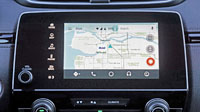
The CR-V’s CVT (continuously variable transmission) offers similar middle-of-road appeal, as it’s a wonderfully smooth operator that only sips away at fuel, but it’s wholly un-sporty. By comparison the RAV4’s eight-speed automatic delivers a more classic automatic feel while achieving more or less the same fuel economy benefits, but just like the CR-V it doesn’t come with a set of steering wheel-mounted paddles to make the most of its sporting potential, whereas top-line trims of Mazda’s CX-5 do include paddle shifters and provide much sportier experiences overall, but Mazda’s six-speed automatic certainly isn’t earning any points for fuel economy or much pop to help the marketing department (a six-speed automatic sounds so passé these days). By comparison, top-tier versions of Ford’s new 2020 Escape should achieve the best performance of all for combining steering wheel paddles with a new eight-speed automatic, plus even stronger power than just mentioned.
Of the four compact crossover SUVs mentioned in this review so far, the CR-V is most efficient in all-important urban tests, plus it’s best when powered by all wheels. Transport Canada gives it an estimated fuel economy rating of 8.4 L/100km in the city, 7.0 on the highway and 7.8 combined when outfitted with FWD, or 8.7 city, 7.2 highway and 8.0 combined with AWD. The RAV4 with FWD slightly improves on the FWD CR-V’s highway number, but not so in the city where most of us drive more often, with a claimed rating of 8.8 city, 6.7 highway and 7.8 combined, while the same crossover with AWD gets a 9.2, 7.1 and 8.3 rating respectively. It wouldn’t be fair for me to omit the RAV4 Hybrid’s fuel economy numbers at this junction, which are easily best in the segment at 5.8 L/100km in the city, 6.3 on the highway and 6.0 combined, this even improving on the CX-5’s 8.9 city, 7.9 highway and 8.4 combined rating for its most efficient diesel powertrain.
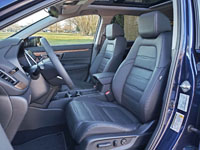
The CX-5’s other fuel economy numbers range from 8.5 to 8.8 combined with FWD or 9.0 to 9.8 with AWD, whereas the Escape is thirstiest amongst this group of best-sellers with combined city/highway ratings of 9.1 with FWD, 9.9 for the AWD version, and 10.2 L/100km for the more potent model.
While we can blame the CR-V’s CVT autobox for its lacklustre performance characteristics, it clearly helps with fuel-efficiency, but CVTs are also often criticized for allowing the engine to rev higher than it normally would with a conventional automatic when pushing hard. To this end the CR-V can be noisy when engine revs climb due to an annoying droning effect during more aggressive acceleration or when passing on the highway, although you shouldn’t experience any aural discomfort when accelerating smoothly and maintaining moderate highway speeds.
This said, despite the RAV4 using a conventional automatic, its cabin is much louder than the CR-V’s overall. In fact, I can’t remember experiencing a louder vehicle in this class or any other, but before Honda lets its pride swell they should stuff a little more sound-deadening insulation ahead of the CR-V’s front firewall, as there’s still too much engine noise seeping into its cabin.
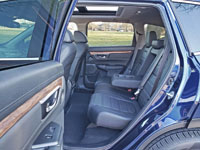
Being comfortable is what matters in this segment after all, and fulfilling this requirement is some of the best ride quality in the class. The CR-V handles fairly well too, unless pushed too hard through fast corners, but when kept to reasonable speeds its fully independent front MacPherson strut and rear multi-link suspension manages very well, not even getting unsettled in back when rolling over deep ruts or big bumps. I found it especially good at negotiating city traffic, but was equally happy with its overall comfort while cruising down the freeway, but head into a curve too quickly and its entire body will lean uncomfortably, so be forewarned.
On that note, performance hounds that still need a modicum of practicality will probably want to take a look at Mazda’s CX-5, which puts out considerably better at high speeds yet still delivers a good ride, in spite of my 2019 tester rolling on 19-inch wheels compared to the CR-V Touring trim’s 18-inch rims. Nevertheless, as much as this type of performance banter might matter to automotive pundits and many of those who read them, all that matters to Honda is the number of CR-V loyalists that come back to purchase another one every three to four years, meaning that the CX-5 might win on the track, but the CR-V wins where it counts most, on the sales charts.
When it’s all said and done, this 2019 CR-V Touring was just as a comfortable and wholly practical as the 2018 CR-V Touring I drove last year (the review of which does a much better job of covering all standard and optional features, which haven’t changed). It’s a family conveyance that I’ll continue to recommend to those who prefer comfort above performance, plus I haven’t heard too many complaints about reliability either, so it’s always nice to listen to crickets instead of comments like, “You told me I should buy this car!”
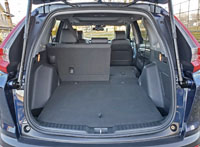
I’m willing to guess that if the CR-V weren’t so dependable it wouldn’t hold its resale value better than any competitor, which it does by the way. It earned the top position amongst car-based compact crossovers in the Canadian Black Book’s 2019 Best Retained Value Awards, took the top spot in its “Compact Utility” segment in ALG’s 2019 Residual Value Awards, plus ruled over its “Compact SUV/Crossover” category in Vincentric’s 2019 Best Value in Canada Awards, which is more of an overall value study, but nevertheless worthy of mention.
In the end, you could do a lot worse than choose one of the most awarded, highest recommended vehicles in its class, which is why Honda’s CR-V remains a leader in its highly contested compact SUV segment.
Story and photo credits: Trevor Hofmann

